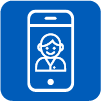Respiratory Outpatient Clinic (ROC)
Updated: August 2021
Due to the COVID-19 pandemic, the Respiratory Outpatient Clinic (ROC) locations will continue to remain closed. However, we still have services and resources available to help.
What resources are available?
Our Children’s Mercy Urgent Care Centers are available for telehealth and in-person visits seven days a week: Monday – Friday, Noon – 10 p.m.; and weekends, 10 a.m. – 8 p.m.
Save My Spot for Urgent Care
Telehealth
Telehealth visits can help you determine if your child needs to be seen for in-person care. This option can also help provide peace of mind and offer guidance, especially after hours. Select a visit time and check-in online using Save My Spot.
Additional services
If you have been advised to bring your child in following a telehealth visit, or your child’s symptoms need immediate attention, please consider the following options:
- Nurse Advice Line: Contact your child’s regular doctor or call the Children’s Mercy Nurse Advice Line: (816) 234-3188.
- Urgent Care: Select an online time slot at one of our Urgent Care locations using Save My Spot to help reduce your wait time.
- Emergency Department: In case of an emergency (or when Urgent Care Centers are closed), please bring your child to one of our Emergency Department locations.
At-home suctioning
The Respiratory Care team has developed the following guide on how to use a manual nasal aspirator to help parents provide suction for their infant at home.
How to use a manual nasal aspirator (PDF)
Cómo usar un aspirador nasal manual (PDF)
- Electronic suctioning devices may also help with ease of suctioning and can be found at many pharmacies and online retailers.
- If a step-by-step tutorial in needed, please search for the manufacturer video for the suction product owned.
- Please also see answers to frequently asked questions about suctioning for bronchiolitis.
What is bronchiolitis?
Bronchiolitis is the most common cause of hospitalization in patients less than 2 years of age. It is a viral infection of the lower respiratory tract. The small breathing tubes in the lungs (bronchioles) fill with mucus, which can make it difficult to breathe. It often is caused by respiratory syncytial virus (RSV). It can also be caused by rhinovirus, influenza, human metapneumovirus or many other viruses. It starts with “common cold” symptoms such as runny nose, fever and cough. Wheezing is very common. It is part of the viral illness and does not mean your child has asthma. Poor feeding might occur because of a stuffy nose or trouble breathing. Prematurity or underlying health problems may lead to more severe illness.
How was my child diagnosed with bronchiolitis?
Health care providers usually diagnose bronchiolitis by talking to you about your child’s illness and examining your child. In most cases, blood work, X-rays and virus tests will not change your child’s treatment. Tests for specific viruses are not always accurate.
Is there any medicine to help my child get better faster?
There are no medications to treat the virus, as antibiotics do not treat viruses. The illness needs to “run its course.” Most patients with bronchiolitis are not helped with albuterol treatments, and cough/cold medications are not beneficial and may have side effects.
How can I help my child at home?
- Use a bulb syringe or other manual nasal aspirator (i.e. Nose-Frida, Nasakleen, etc.) to suction mucous from the nose. Put two drops of nasal saline (saltwater) in each nostril before suctioning. This may help remove more mucus.
- Suction before feeding, before sleeping or if your child appears uncomfortable.
- Make sure your child drinks plenty of fluids. Your child may drink smaller amounts than normal. Give fluids more frequently.
- Do not let anyone smoke near your child. This can make his or her symptoms worse.
- Acetaminophen and (for children over 6 months) ibuprofen can be used for fever and fussiness.
- Wash your hands often to help prevent spread of the virus to others.
When should I bring my child back for bronchiolitis?
Your child should be seen for:
|
Difficulty breathing
|
|
|
Fever higher than 101 for more than five days |
|
 |
Signs of dehydration (no tears, dry mouth or fewer wet diapers) |
|
If you have any other concerns |
|
 |
Contact your child’s regular doctor or call the Children’s Mercy Nurse Advice Line: (816) 234-3188 Our Urgent Care locations are available for telehealth and in-person visits seven days a week:
|
 |
|
Cough and congestion may last for up to 14 days. Remember to follow up with your child’s health care provider if you believe additional care is needed.
- Pulmonary and Sleep Medicine
- Advanced Asthma Interdisciplinary Respiratory (AAIR) Clinic
- Cystic Fibrosis Care Center
- Pediatric Pulmonology Fellowship
- Pulmonary Hypertension Clinic
- Respiratory Outpatient Clinic (ROC)
- Respiratory Outpatient Clinic: Update for Providers
- Sleep Center
- Sleep Medicine Fellowship
- PHIL Award Nomination Form
- Meet the Team